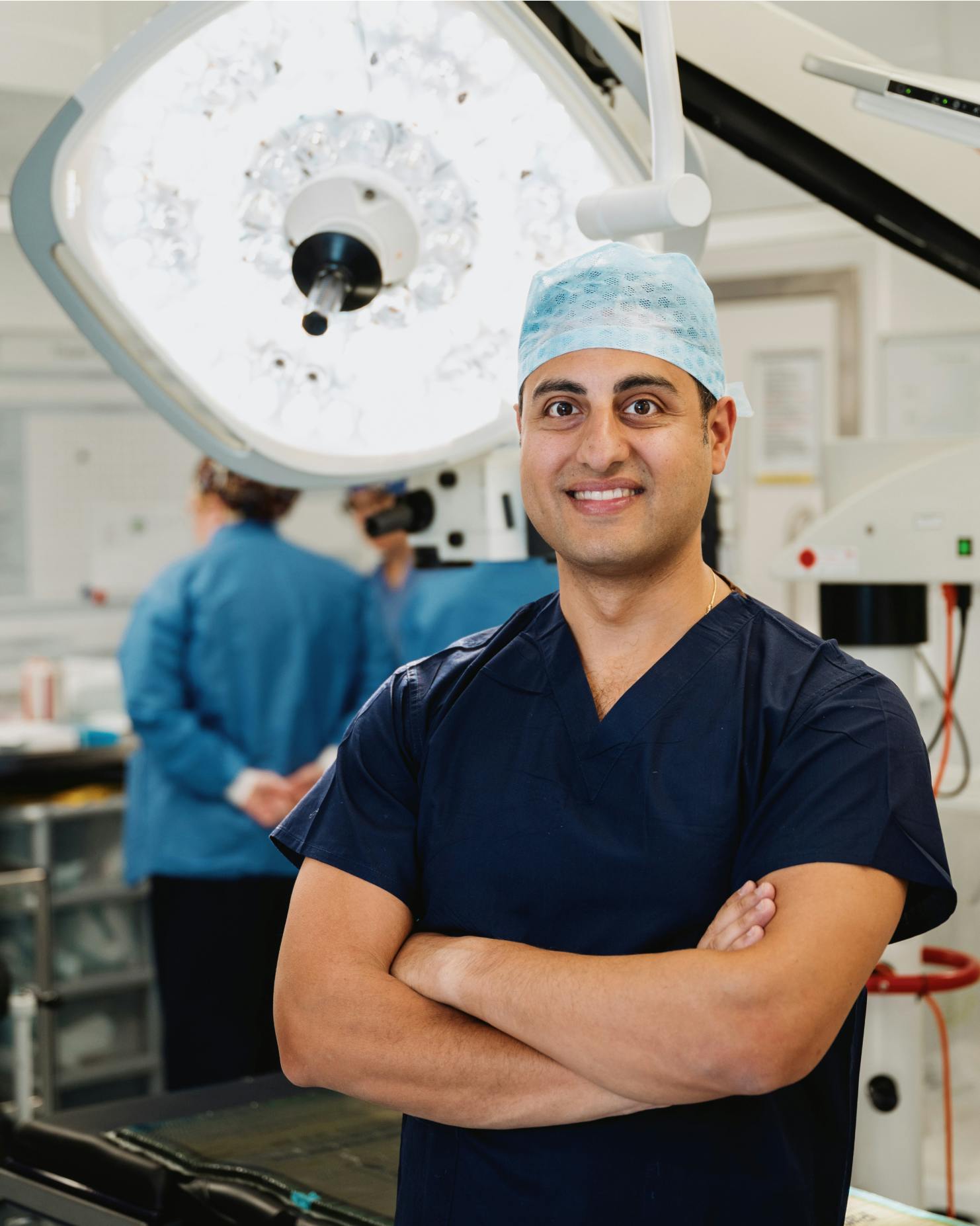
Cataracts and Refractive lens exchange
What is cataract surgery?
Cataract surgery is a highly effective procedure designed to restore clear vision by replacing the eye’s natural lens, which has become cloudy due to cataracts. Cataracts develop gradually, often due to aging, causing symptoms such as blurry or hazy vision, increased sensitivity to light and glare, difficulty seeing at night, faded or yellowed colors, and frequent changes in glasses prescription.
During cataract surgery, the cloudy lens is removed and replaced with an artificial intraocular lens (IOL), improving vision and reducing dependence on glasses or contact lenses.
Why is cataract surgery performed?
Cataract surgery restores clear vision impaired by cataracts, preventing further vision loss or blindness. Without treatment, cataracts can worsen, making everyday activities such as reading, driving, and recognising faces difficult. While aging is the most common cause, cataracts can also result from diabetes, prolonged UV exposure, smoking, previous eye injuries or surgeries, or genetic predisposition.
What happens during cataract surgery?
Cataract surgery is a minimally invasive outpatient procedure performed under local anesthesia with numbing eye drops. The procedure typically takes 15 to 20 minutes per eye. A small incision is made at the edge of the cornea, and an ultrasound probe breaks down the cloudy lens into tiny fragments. These fragments are gently removed, and an artificial intraocular lens is inserted into the lens capsule. The eye is then flushed with fluids and antibiotics to promote healing and prevent infection.
Types of Intraocular Lenses for cataract surgery
There are different types of intraocular lenses depending on vision needs. Monofocal intraocular lenses provide clear vision at a single distance, usually for distance vision, requiring glasses for intermediate and near tasks. Enhanced monofocal or extended depth of focus intraocular lenses, usually for distant and intermediate vision requiring glasses for reading. Multifocal intraocular lenses improve vision at near, intermediate, and far distances, reducing reliance on glasses. Toric intraocular lenses are designed to correct astigmatism, enhancing overall sharpness and clarity.
Recovery and Aftercare for cataract surgery
Most patients experience improved vision within a few days, with full recovery taking a few weeks. To ensure optimal healing, it is advised to avoid strenuous activities and heavy lifting for at least a week, use prescribed eye drops to prevent infection and reduce inflammation, attend follow-up appointments, and refrain from rubbing the eyes or exposing them to dust and irritants.
What is refractive lens exchange?
Refractive lens exchange, also known as lens replacement surgery or clear lens extraction, is a procedure similar to cataract surgery but performed on individuals who do not yet have cataracts. Instead of treating clouded vision, refractive lens exchange corrects extreme farsightedness (hyperopia) or presbyopia (age-related difficulty focusing on nearby objects). Like cataract surgery, it involves removing the eye’s natural lens and replacing it with a synthetic intraocular lens to enhance visual clarity and reduce the need for glasses or contact lenses.
The procedure is sometimes abbreviated as RLE, which may be familiar to some patients, but we will primarily use the full term for clarity.
Why is refractive lens exchange performed?
Refractive lens exchange is typically recommended for individuals over 50 whose prescription is too strong for laser eye surgery. It is particularly beneficial for those with severe hyperopia or presbyopia, helping them achieve clearer vision without relying on corrective eyewear. Additionally, undergoing refractive lens exchange eliminates the risk of developing cataracts later in life, as the natural lens is already replaced with an intraocular lens. Some patients with significant astigmatism can also benefit, as specialized toric intraocular lenses can correct this condition.
What happens during refractive lens exchange?
Refractive lens exchange is a quick, minimally invasive procedure performed under local anesthesia with numbing eye drops. The surgery typically lasts about 20 minutes per eye and is conducted on an outpatient basis, meaning patients can return home the same day. A small incision is made at the edge of the cornea, the thin membrane covering the natural lens is opened, and the natural lens is gently removed using advanced ultrasound technology. A synthetic intraocular lens is implanted in its place, and the eye is flushed with fluids and antibiotics to promote healing and reduce infection risk.
Types of Intraocular Lenses for refractive lens exchange
The choice of intraocular lens depends on individual vision needs. Monofocal intraocular lenses provide clear vision at a single distance, typically for distance vision, requiring reading glasses for near tasks. Multifocal intraocular lenses offer multiple focal points, improving vision at near, intermediate, and far distances. Toric intraocular lenses are specifically designed to correct astigmatism.
Preparing for surgery
Whether undergoing cataract surgery or refractive lens exchange, an eye specialist will conduct a thorough assessment beforehand. This includes measuring the shape and size of the eye to determine the best type of intraocular lens for the patient's vision needs. Unlike some corrective procedures, neither cataract surgery nor refractive lens exchange requires extensive preparation, though the surgeon may advise stopping certain medications or eye drops beforehand.
Alternatives to refractive lens exchange
If refractive lens exchange is not suitable, other vision correction options may be considered. Laser eye surgery, such as LASIK or PRK, uses a laser to reshape the cornea and improve focus without replacing the lens. Phakic intraocular lens implantation (PIOL) involves inserting an additional lens inside the eye without removing the natural lens, often a preferred option for younger patients. However, for individuals over 50, refractive lens exchange is often the best long-term solution as it addresses both refractive errors and the potential development of cataracts in one procedure.
Conclusion
Both cataract surgery and refractive lens exchange offer transformative vision correction solutions, enhancing quality of life and reducing dependency on glasses or contact lenses. If you are considering vision correction surgery, consulting an eye specialist will help determine the best option for your specific needs and lifestyle.